Critical Ergonomics and (Dis)Comfort Factors While Performing Tasks with Hand Tools on a Ladder: A Pilot Study
Abstract
1. Introduction
2. Material and Methods
2.1. Purpose
2.2. Pilot Tests to Identify the Critical Tasks
- (1)
- Top screwing: representative of all those operations that require the arms to be raised, with possibly the handling of a tool needed to carry out the operation, and a force exertion in the vertical direction. This group includes operations such as: screwing at the top of a ceiling, drilling at the top, painting the ceiling, changing a light bulb, etc. (Figure 1a).
- (2)
- Frontal screwing: representative of all those operations that require the arms to be maintained horizontally to carry out the operation, with possibly the handling of a tool needed to carry out the operation far from the body’s center of gravity and force-exertion in the horizontal direction. This group includes operations such as frontal screwing, frontal drilling, wall painting, fixing of a frame, etc. (Figure 1b).
- (3)
- Object picking from bottom forward: representative of all those operations that require a forward bend with a vertical applied load, for example, to pose or take an object positioned in front of the ladder, in a lowered position (Figure 1c).
- (4)
- Object picking from the bottom sideways: representative of all those operations that require a downward bending and a twist of the torso with a vertical applied load, for example, to pose or take an object positioned laterally on the ladder, in a lowered position (Figure 1d).
2.3. Participants
2.4. Experimental Setup
- (1)
- Top screwing:
- -
- Ladder leaning against the wall
- -
- Drilling height is equal to 210 cm, measured from the plane on which the user placed his feet (the floor and the second step of the telescopic ladder in the case of screwing on a ladder)
- -
- Drilling is to be made about 7 cm from the wall
- (2)
- Frontal screwing:
- -
- Ladder leaning against the wall
- -
- Height at which the drill is equal to 153 cm, measured from the plane on which the user placed his feet (the floor and the second step of the telescopic ladder in the case of screwing on a ladder)
- (3)
- Object picking from bottom forward:
- -
- Object height to be picked/deposited equal to 61 cm, measured from the plane on which the user placed his feet (the floor and the second step of the telescopic ladder in the case of screwing on a ladder)
- -
- The front distance of the object to be picked up/deposited is equal to 65 cm
- (4)
- Object picking from the bottom sideways:
- -
- Object height to be picked up/deposited equal to 61 cm, measured from the plane on which the user placed his feet (the floor and the second step of the telescopic ladder in the case of screwing on a ladder)
- -
- The lateral distance of the object to be picked up/deposited is equal to 70 cm.
2.5. Test Procedure
- -
- Frontal screwing on the ladder.
- -
- Frontal screwing from the ground.
- -
- Top screwing on the ladder.
- -
- Top screwing from the ground.
- -
- Sideways object picking on the ladder.
- -
- Sideways object picking from the ground.
- -
- Frontal object picking on the ladder.
- -
- Frontal object picking from the ground.
2.6. Questionnaire
3. Postural Data Acquisition
- For the neck: frontal flexion, rotation, and lateral flexion.
- For the shoulder: frontal flexion, abduction/adduction.
- For the elbow: flexion/extension, pronation/supination.
- For the wrist: flexion/extension, radio/ulnar deviation.
4. Result and Discussion
- -
- Frontal screwing
- -
- Top screwing
- -
- Sideways object picking
- -
- Frontal object picking
5. Limitations
6. Conclusions
Author Contributions
Funding
Institutional Review Board Statement
Informed Consent Statement
Data Availability Statement
Conflicts of Interest
References
- Shepherd, G.W.; Kahler, R.J.; Cross, J. Ergonomic design interventions—A case study involving portable ladders. Ergonomics 2006, 49, 221–234. [Google Scholar] [CrossRef]
- Jüptner, H. Safety on ladders: An ergonomic design approach. Appl. Ergon. 1976, 7, 221–223. [Google Scholar] [CrossRef]
- Bloswick, D.S.; Chaffin, D.B. An ergonomic analysis of the ladder climbing activity. Int. J. Ind. Ergon. 1990, 6, 17–27. [Google Scholar] [CrossRef]
- Dewar, M.E. Body Movements in Climbing a Ladder. Ergonomics 1977, 20, 67–86. [Google Scholar] [CrossRef] [PubMed]
- Ribeiro, B.F. Occupational hazards in window cleaning. BMJ 1975, 3, 530–532. [Google Scholar] [CrossRef] [PubMed][Green Version]
- Young, S.L.; Wogalter, M.S. On improving set-up angle accuracy for extension ladders. In Proceedings of the XIVth Triennial Congress of the International Ergonomics Association and the 44th Annual Meeting of the Human Factors and Ergonomics Society: Ergonomics for the New Millennium, San Diego, CA, USA, 29 July–4 August 2000; pp. 111–114. [Google Scholar]
- National Safety Council Injury. National Safety Council Injury Facts 2. Injury Fact; National Safety Council: Chicago, IL, USA, 2013. [Google Scholar]
- Rockett, I.R.H.; Regier, M.D.; Kapusta, N.D.; Coben, J.H.; Miller, T.R.; Hanzlick, R.L.; Todd, K.H.; Sattin, R.W.; Kennedy, L.W.; Kleinig, J.; et al. Leading Causes of Unintentional and Intentional Injury Mortality: United States, 2000–2009. Am. J. Public Health 2012, 102, e84–e92. [Google Scholar] [CrossRef]
- Lombardi, D.A.; Smith, G.S.; Courtney, T.K.; Brennan, M.J.; Kim, J.Y.; Perry, M.J. Work-related falls from ladders—A follow-back study of US emergency department cases. Scand. J. Work Environ. Health 2011, 37, 525–532. [Google Scholar] [CrossRef]
- Marsh, S.M.; Jackson, L.L. A comparison of fatal occupational injury event characteristics from the Census of Fatal Occupational Injuries and the Vital Statistics Mortality System. J. Saf. Res. 2013, 46, 119–125. [Google Scholar] [CrossRef]
- Pliner, E.M.; Campbell-Kyureghyan, N.H.; Beschorner, K.E. Effects of foot placement, hand positioning, age and climbing biodynamics on ladder slip outcomes. Ergonomics 2014, 57, 1739–1749. [Google Scholar] [CrossRef]
- Pliner, E.; Beschorner, K. Effects of Ladder Climbing Patterns on Fall Severity. Proc. Hum. Factors Ergon. Soc. Annu. Meet. 2017, 61, 940–944. [Google Scholar] [CrossRef]
- Pliner, E.M.; Seo, N.J.; Beschorner, K.E. Factors affecting fall severity from a ladder: Impact of climbing direction, gloves, gender and adaptation. Appl Ergon. 2017, 60, 163–170. [Google Scholar] [CrossRef]
- ANSI ASC A14.5-2017: Ladders—Portable Reinforced Plastic—Safety Requirements. Available online: www.americanladderinstitute.org (accessed on 20 December 2023).
- Hsiao, H.; Simeonov, P.; Pizatella, T.; Stout, N.; McDougall, V.; Weeks, J. Extension-ladder safety: Solutions and knowledge gaps. Int. J. Ind. Ergon. 2008, 38, 959–965. [Google Scholar] [CrossRef]
- Ronk, C.J.; Dennerlein, J.T.; Hoffman, E.; Perry, M.J. Is renovation riskier than new construction? An observational comparison of risk factors for stepladder-related falls. Am. J. Ind. Med. 2011, 54, 579–585. [Google Scholar] [CrossRef] [PubMed]
- Young, J.G.; Woolley, C.; Armstrong, T.J.; Ashton-Miller, J.A. Hand-handhold coupling: Effect of handle shape, orientation, and friction on breakaway strength. Hum. Factors: J. Hum. Factors Ergon. Soc. 2009, 51, 705–717. [Google Scholar] [CrossRef] [PubMed]
- Barnett, R.; Poczynok, P. Ladder rung vs. siderail hand grip strategies. Saf. Br. 2000, 16, 1–15. Available online: https://www.scopus.com/inward/record.uri?eid=2-s2.00346549447&partnerID=40&md5=267fd759b67506c915dcab22a98e925c (accessed on 15 December 2023).
- Simeonov, P.; Hsiao, H.; Armstrong, T.; Fu, Q.; Woolley, C.; Kau, T.-Y. Effects of aerial ladder rung spacing on firefighter climbing biomechanics. Appl. Ergon. 2019, 82, 102911. [Google Scholar] [CrossRef] [PubMed]
- Knox, E.H.; Van Bree, M.P. Field Studies and Labeling Research on the Angle of Inclination of Non-Self Supporting Ladders. In Proceedings of the 2010 International Conference on Fall Prevention and Protection, Morgantown, WV, USA, 18–20 May 2010; p. 157. [Google Scholar]
- Simeonov, P.; Hsiao, H.; Kim, I.-J.; Powers, J.R.; Kau, T.-Y. Factors Affecting Extension Ladder Angular Positioning. Hum. Factors J. Hum. Factors Ergon. Soc. 2012, 54, 334–345. [Google Scholar] [CrossRef]
- Campbell, A.O.; Pagano, C.C. The effect of instructions on potential slide-out failures during portable extension ladder angular positioning. Accid. Anal. Prev. 2014, 67, 30–39. [Google Scholar] [CrossRef]
- Simeonov, P.; Hsiao, H.; Powers, J.; Kim, I.-J.; Kau, T.-Y.; Weaver, D. Research to improve extension ladder angular positioning. Appl. Ergon. 2012, 44, 496–502. [Google Scholar] [CrossRef][Green Version]
- Hoozemans, M.J.; de Looze, M.P.; Kingma, I.; Reijneveld, K.C.; de Korte, E.M.; van der Grinten, M.P.; van Dieën, J.H. Workload of window cleaners using ladders differing in rung separation. Appl. Ergon. 2005, 36, 275–282. [Google Scholar] [CrossRef]
- Thamsuwan, O.; Aulck, L.; Galvin, K.; Johnson, P.W. Comparison of Exposure to Repetitive Upper Arm Motions and Non-neutral Upper Arm Postures between Apple Harvesting with Ladders and Mobile Platforms. Proc. Hum. Factors Ergon. Soc. Annu. Meet. 2014, 58, 1585–1589. [Google Scholar] [CrossRef]
- Thamsuwan, O.; Johnson, P.W. Comparing Upper Arm and Back Postural Exposures between Apple Harvesting with Ladders and Mobile Platform. Proc. Hum. Factors Ergon. Soc. Annu. Meet. 2015, 59, 1252–1256. [Google Scholar] [CrossRef]
- Thamsuwan, O.; Galvin, K.; Tchong-French, M.; Kim, J.H.; Johnson, P.W. A feasibility study comparing objective and subjective field-based physical exposure measurements during apple harvesting with ladders and mobile platforms. J. Agromedicine 2019, 24, 268–278. [Google Scholar] [CrossRef]
- Zhang, Z.; Wang, Y.; Zhang, Z.; Li, D.; Wu, Z.; Bai, R.; Meng, G. Ergonomic and efficiency analysis of conventional apple harvest process. Int. J. Agric. Biol. Eng. 2019, 12, 210–217. [Google Scholar] [CrossRef]
- Zhang, Z.; Zhang, Z.; Wang, W.; Liu, H.; Sun, Z. The Role of a New Harvest Platform in Alleviation of Apple Workers’ Occupational Injuries During Harvest. J. Agric. Saf. Health 2019, 25, 11–24. [Google Scholar] [CrossRef] [PubMed]
- McAtamney, L.; Corlett, E.N. RULA: A survey method for the investigation of work-related upper limb disorders. Appl. Ergon. 1993, 24, 91–99. [Google Scholar] [CrossRef] [PubMed]
- Grinten, M.P. Development of a pratical method for measuring body part discomfort. In Advances in Industrial Egonomics and Safety IV; Taylor and Francis: London, UK, 1992; pp. 311–318. [Google Scholar]
- Joshi, A.; Kale, S.; Chandel, S.; Pal, D.K. Likert Scale: Explored and Explained. Br. J. Appl. Sci. Technol. 2015, 7, 396–403. [Google Scholar] [CrossRef]
- Corlett, E.N.; Bishop, R.P. A Technique for Assessing Postural Discomfort. Ergonomics 1976, 19, 175–182. [Google Scholar] [CrossRef]
- Smulders, M.; Berghman, K.; Koenraads, M.; Kane, J.; Krishna, K.; Carter, T.; Schultheis, U. Comfort and pressure distribution in a human contour shaped aircraft seat (developed with 3D scans of the human body). Work 2016, 54, 925–940. [Google Scholar] [CrossRef]
- Califano, R.; Naddeo, A.; Vink, P. The effect of human-mattress interface’s temperature on perceived thermal comfort. Appl. Ergon. 2017, 58, 334–341. [Google Scholar] [CrossRef]
- Naddeo, A.; Cappetti, N.; D’Oria, C. Proposal of a new quantitative method for postural comfort evaluation. Int. J. Ind. Ergon. 2015, 48, 25–35. [Google Scholar] [CrossRef]
- Naddeo, A.; Cappetti, N.; Vallone, M.; Califano, R. New trend line of research about comfort evaluation: Proposal of a framework for weighing and evaluating contributes coming from cognitive, postural and physiologic comfort perceptions. In Proceedings of the 5th International Conference on Applied Human Factors and Ergonomics AHFE 2014, Kraków, Poland, 19–23 July 2014; pp. 503–515. [Google Scholar] [CrossRef]
- Apostolico, A.; Cappetti, N.; D’oria, C.; Naddeo, A.; Sestri, M. Postural comfort evaluation: Experimental identification of Range of Rest Posture for human articular joints. Int. J. Interact. Des. Manuf. (IJIDeM) 2013, 8, 109–120. [Google Scholar] [CrossRef]
- Borg, G.A. Psychophysical bases of perceived exertion. Med. Sci. Sports Exerc. 1982, 14, 377–381. [Google Scholar] [CrossRef]
- Alessandro, N.; Sandro, M. Postural Comfort Inside a Car: Development of an Innovative Model to Evaluate the Discomfort Level. SAE Int. J. Passeng. Cars Mech. Syst. 2009, 2, 1065–1070. [Google Scholar] [CrossRef]
- Fisher, R.A. Statistical Methods for Research Workers. In Breakthroughs in Statistics: Methodology and Distribution; Kotz, S., Johnson, N.L., Eds.; Springer: New York, NY, USA, 1992; pp. 66–70. [Google Scholar] [CrossRef]
- Eminoğlu, M.; Ozguven, M.; Beyaz, A.; Acar, A. Determining Postural Discomfort at Working with Power Tiller. In Proceedings of the 9th International Conference on Energy Efficiency & Agricultural Engineering, Ruse, Bulgaria, 27–29 June 2009. [Google Scholar]
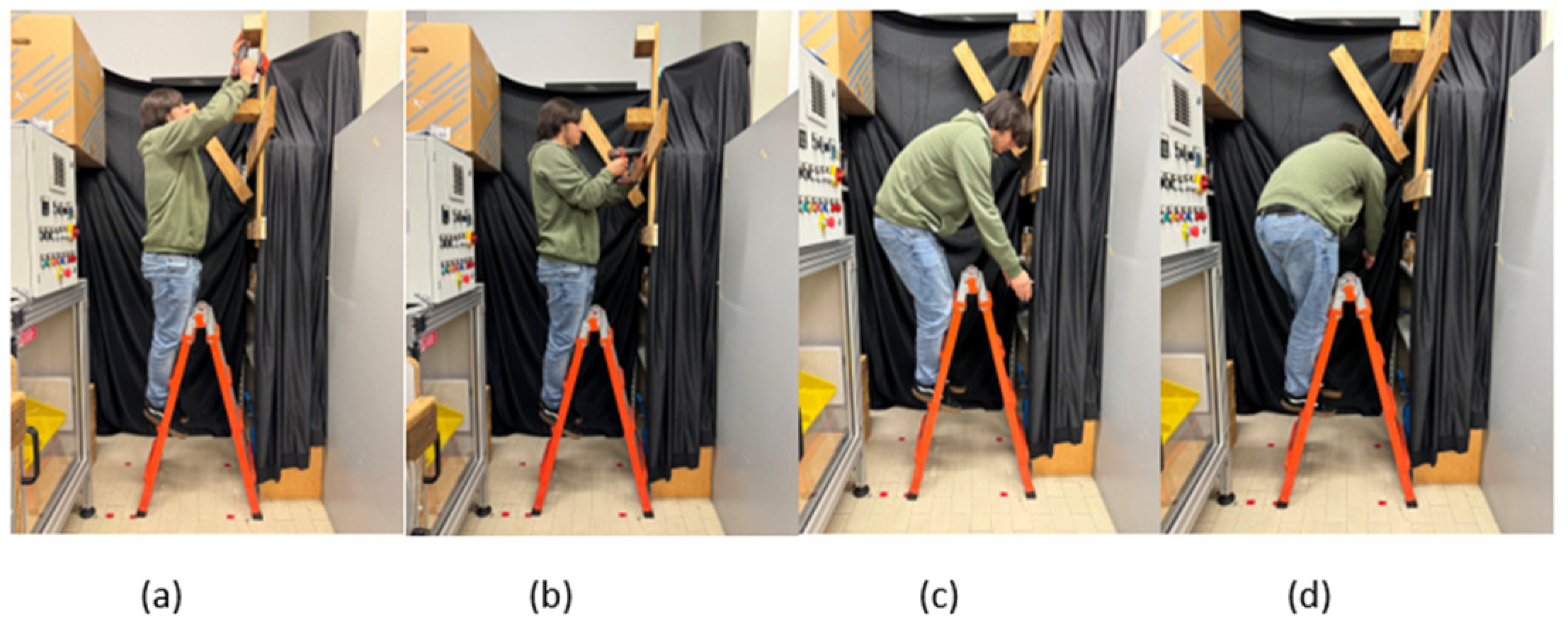
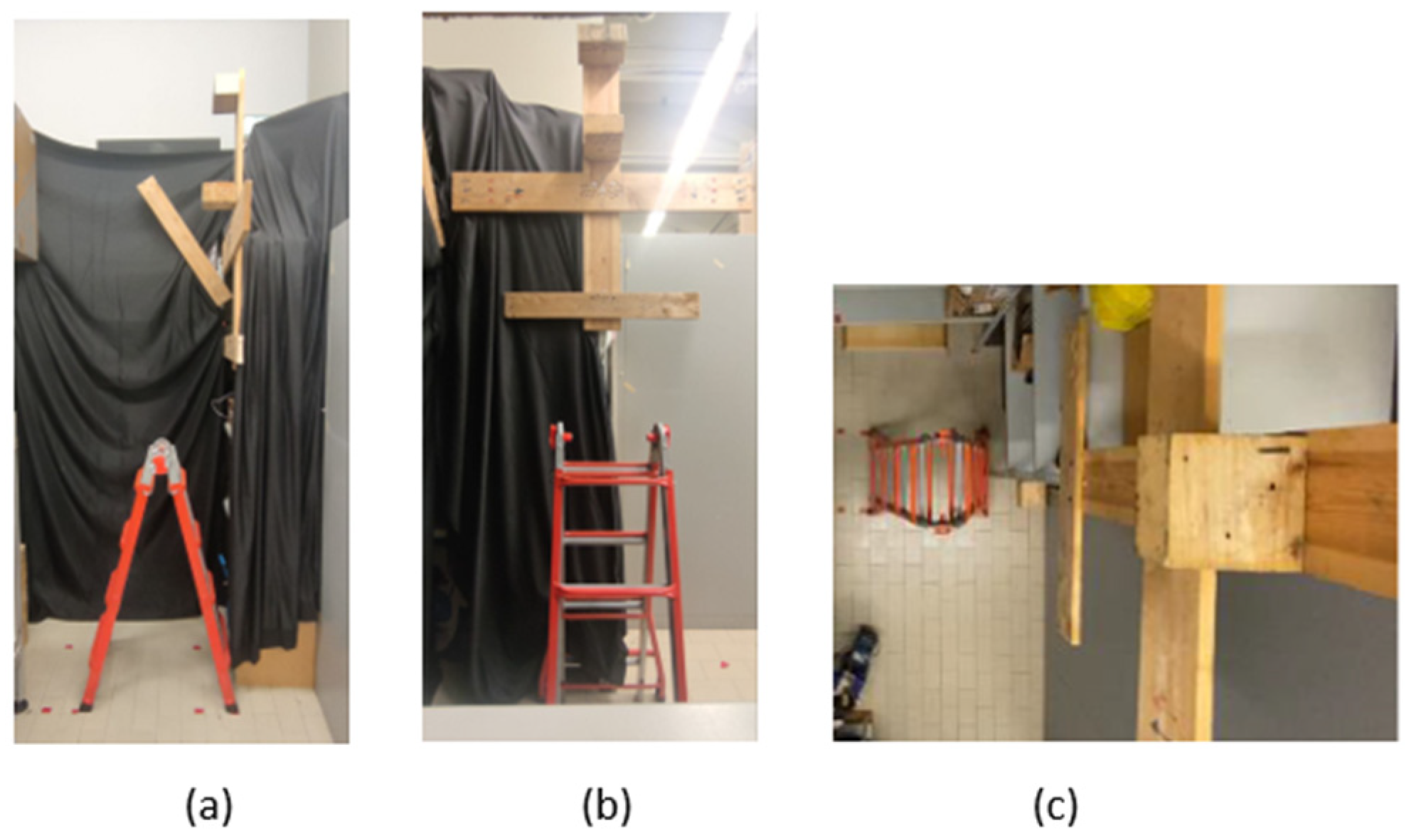
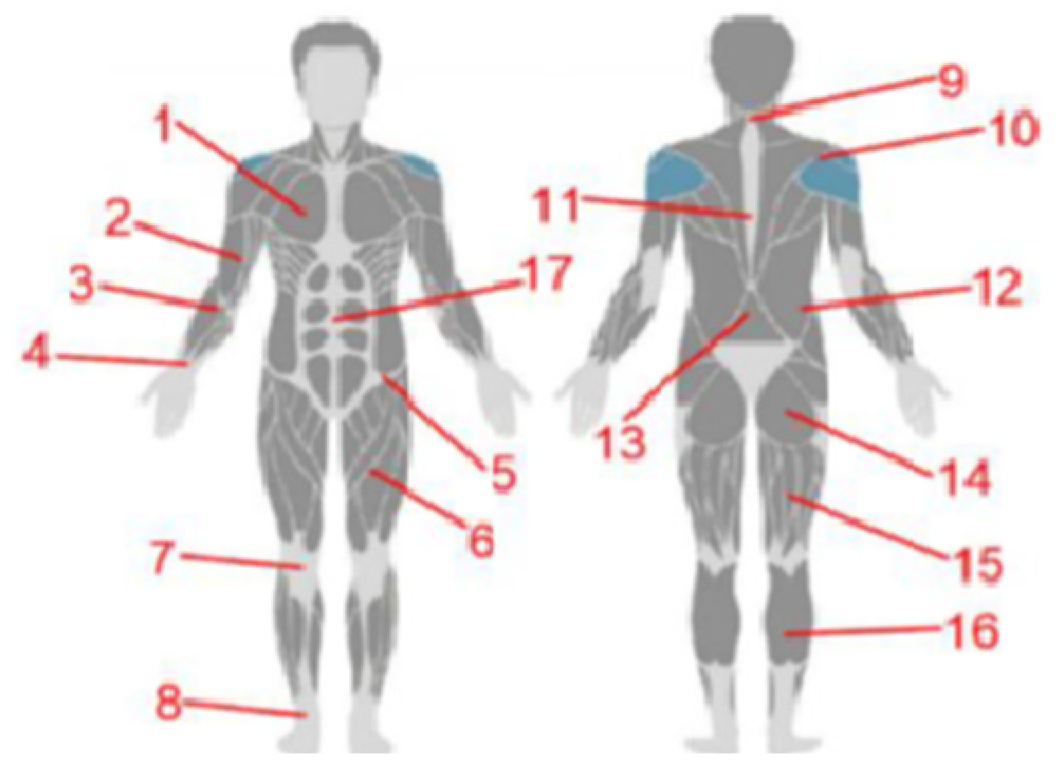
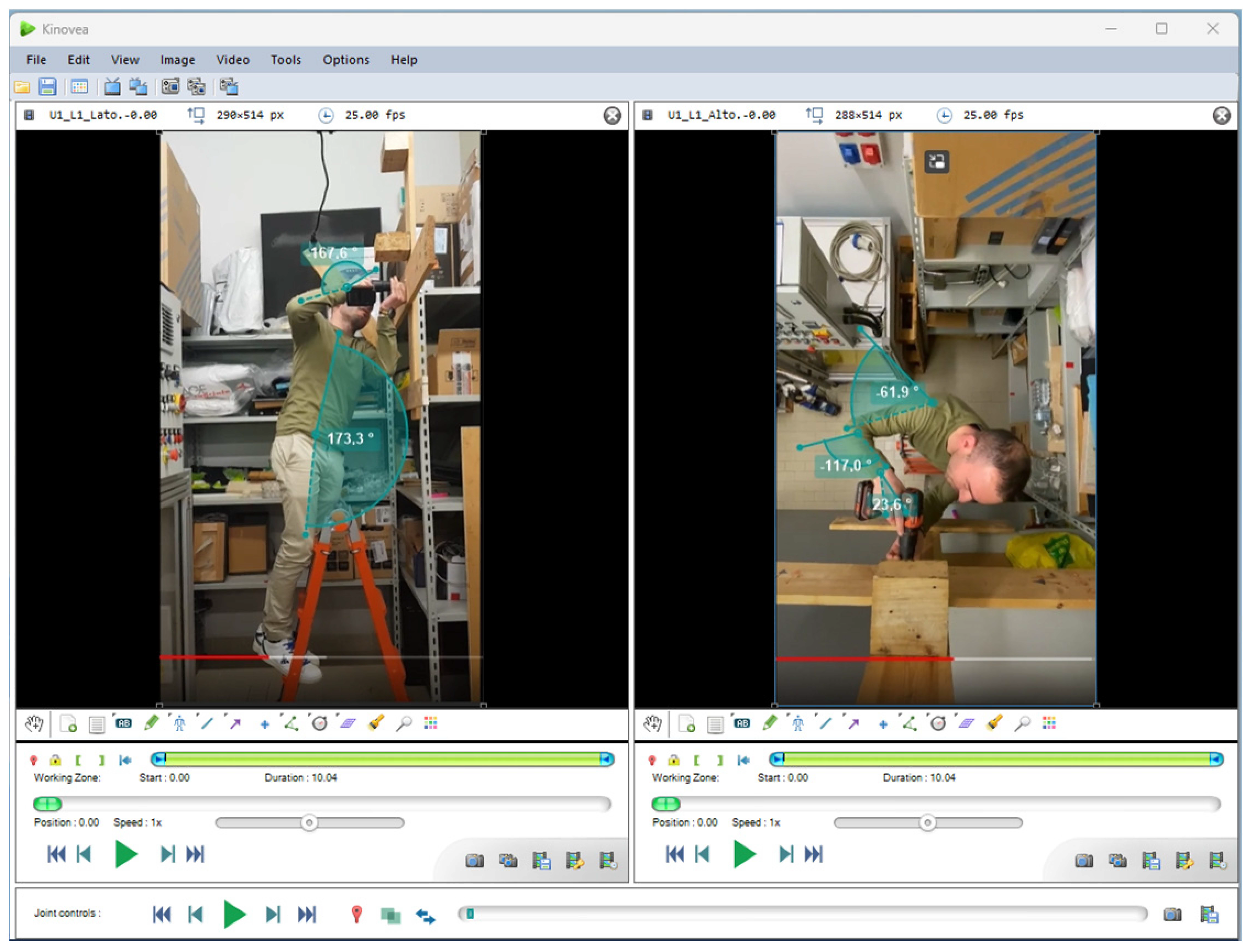
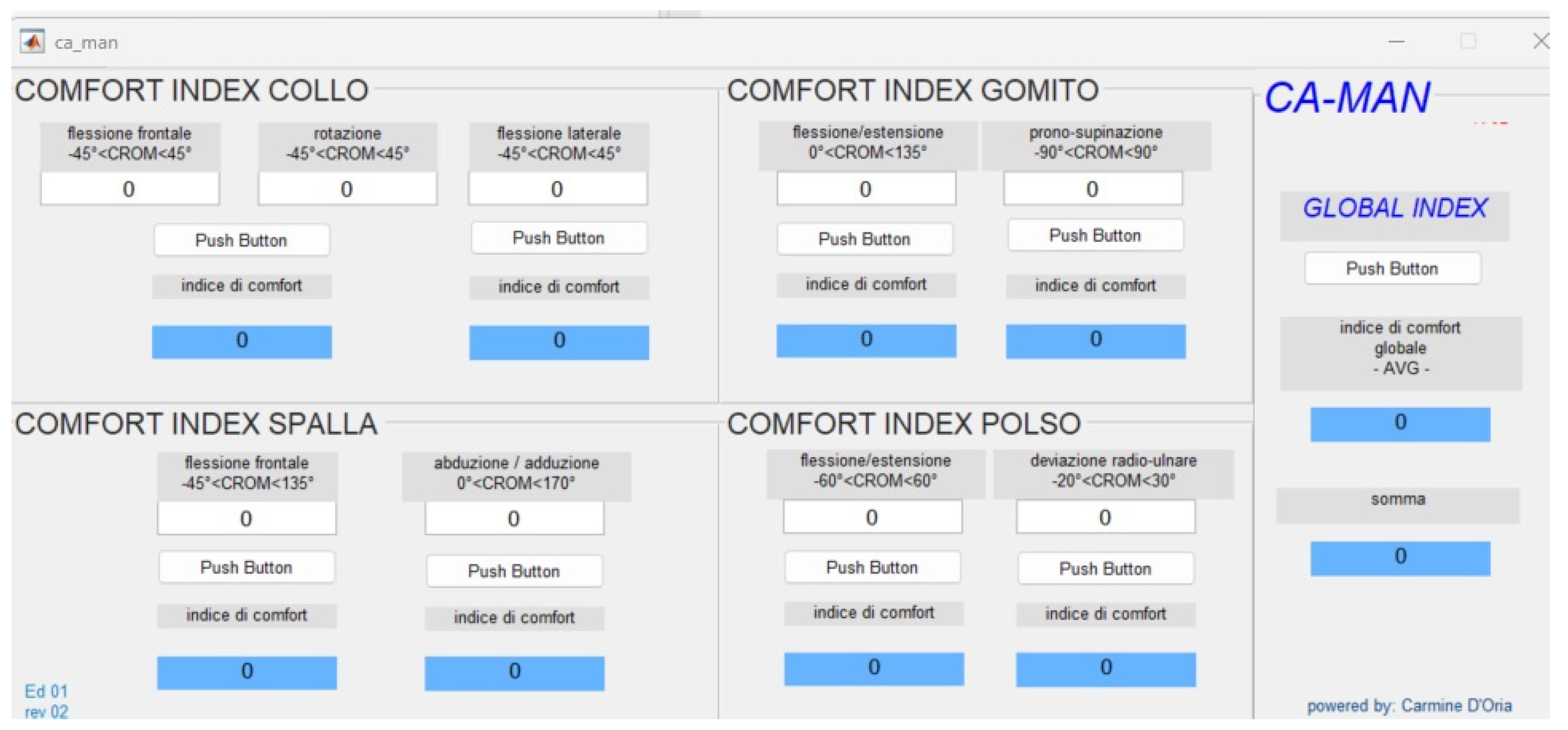
| Age (Years) | Height (cm) | Weight (kg) | |
|---|---|---|---|
| Mean | 27 | 175.1 | 76.3 |
| Std. Deviation | 5.6 | 7.8 | 13.37 |
| Frontal Screwing | RULA (Right) | RULA (Left) | Perceived Discomfort | Effort Needed | Left Knee | Right Knee | Wrist-Hand Posture Evaluation | CAMan (Right) | CAMan (Left) |
|---|---|---|---|---|---|---|---|---|---|
| Mean (Ladder) | 4.57 | 3.29 | 4.05 | 1.32 | 1.18 | 1.18 | 2.45 | 7.08 | 7.15 |
| St. Dev. (Ladder) | 0.81 | 0.56 | 2.21 | 0.65 | 2.06 | 1.82 | 0.67 | 0.81 | 0.90 |
| Mean (Ground) | 4.38 | 3.24 | 2.73 | 1.18 | 0.05 | 0.09 | 2.05 | 7.59 | 8.11 |
| St. Dev. (Ground) | 0.59 | 0.54 | 2.05 | 0.50 | 0.21 | 0.43 | 0.79 | 0.78 | 0.90 |
| Mean Difference | 0.19 | 0.05 | 1.32 | 0.14 | 1.14 | 1.09 | 0.41 | 0.51 | 0.96 |
| Stochastic Significance | NO | NO | YES | NO | YES | YES | YES | YES | YES |
| Frontal Screwing Correlation | Left Knee | Right Knee | CAMan Global |
|---|---|---|---|
| Perceived Discomfort | 0.443 * | 0.467 * | −0.596 ** |
| Height | −0.477 * | −0.442 * | - |
| RULA (right) | - | - | −0.406 * |
| RULA (left) | - | - | −0.447 * |
| Top Screwing | RULA (Right) | RULA (Left) | Perceived Discomfort | Effort Needed | Left Knee | Right Knee | Wrist-Hand Posture Evaluation | CAMan (Right) | CAMan (Left) |
|---|---|---|---|---|---|---|---|---|---|
| Mean (Ladder) | 6.95 | 6.19 | 5.82 | 2.27 | 1.82 | 2.27 | 3.36 | 6.80 | 6.85 |
| St. Dev. (Ladder) | 0.22 | 0.75 | 2.79 | 1.08 | 2.82 | 2.96 | 1.09 | 0.37 | 0.41 |
| Mean (Ground) | 5.7 | 6.19 | 4.27 | 1.68 | 1.27 | 0.27 | 2.86 | 7.30 | 7.10 |
| St. Dev. (Ground) | 0.44 | 0.75 | 2.05 | 0.89 | 0.94 | 0.94 | 0.94 | 0.81 | 0.74 |
| Mean Difference | 0.19 | 0.00 | 1.55 | 0.59 | 1.55 | 2.00 | 0.50 | 0.50 | 0.25 |
| Stochastic Significance | YES | NO | YES | YES | YES | YES | NO | YES | YES |
| Top Screwing Correlation | Effort Needed Perceived | Right Knee | Left Knee | CAMan Global |
|---|---|---|---|---|
| Perceived Discomfort | 0.829 ** | 0.510 * | 0.476 * | −0.737 ** |
| Right arm | 0.735 ** | - | - | −0.475 * |
| Left arm | - | - | - | −0.499 * |
| Right forearm | 0.466 * | - | - | - |
| Right wrist | 0.439 * | - | - | - |
| Right shoulder | 0.505 * | - | - | - |
| Right knee | 0.605 ** | - | - | - |
| Effort needed | 1 | 0.606 * | 0.467 * | 0.479 * |
| Height | - | −0.650 ** | −0.644 ** | - |
| Sideways Object Picking | RULA (Right) | RULA (Left) | Perceived Discomfort | Effort Needed | Left Knee | Right Knee | CAMan (Right) | CAMan (Left) |
|---|---|---|---|---|---|---|---|---|
| Mean (Ladder) | 5.77 | 5.77 | 3.81 | 1.37 | 1.52 | 1.67 | 5.67 | 7.08 |
| St. Dev. (Ladder) | 0.59 | 0.59 | 2.09 | 0.69 | 2.74 | 2.70 | 0.75 | 0.27 |
| Mean (Ground) | 5.69 | 5.69 | 2.81 | 1.19 | 0.48 | 0.26 | 6.43 | 7.59 |
| St. Dev. (Ground) | 0.62 | 0.62 | 1.83 | 0.40 | 1.40 | 1.16 | 0.14 | 0.50 |
| Mean Difference | 0.08 | 0.08 | 0.93 | 0.19 | 1.04 | 1.41 | 0.76 | 0.51 |
| Stochastic Significance | NO | NO | YES | NO | YES | YES | YES | YES |
| Sideways Object Picking Correlation | Perceived Discomfort | Effort Needed Perceived |
|---|---|---|
| Right arm | 0.676 ** | 0.534 ** |
| Left arm | 0.562 ** | 0.508 ** |
| Right forearm | 0.541 ** | 0.447 * |
| Left forearm | 0.403 * | - |
| Right knee | 0.587 ** | 0.405 * |
| Left knee | 0.568 ** | 0.484 * |
| Upper back | 0.512 * | - |
| Lower back | 0.472 * | - |
| Right leg | 0.479 * | 0.394 * |
| Left leg | 0.510 ** | 0.394 * |
| Perceived Discomfort | 1 | 0.655 ** |
| CaMan global | −0.655 ** | - |
| Sideways Object Picking | RULA (Right) | RULA (Left) | Perceived Discomfort | Effort Needed | Left Knee | Right Knee | CAMan (Right) | CAMan (Left) |
|---|---|---|---|---|---|---|---|---|
| Mean (Ladder) | 5.04 | 5.04 | 3.33 | 1.26 | 2.30 | 2.00 | 8.60 | 8.74 |
| St. Dev. (Ladder) | 0.92 | 1.00 | 2.06 | 0.45 | 2.92 | 2.77 | 1.01 | 0.96 |
| Mean (Ground) | 4.96 | 4.96 | 2.44 | 1.19 | 0.19 | 0.19 | 8.72 | 8.90 |
| St. Dev. (Ground) | 0.82 | 0.82 | 1.34 | 0.48 | 0.96 | 0.96 | 0.90 | 0.42 |
| Mean Difference | 0.08 | 0.08 | 0.89 | 0.07 | 2.11 | 1.81 | 0.12 | 0.16 |
| Stochastic Significance | NO | NO | YES | NO | YES | YES | NO | NO |
| Frontal Object Picking Correlation | Perceived Discomfort | Effort Needed Perceived |
|---|---|---|
| Right arm | 0.568 ** | 0.589 ** |
| Left arm | 0.567 ** | 0.509 ** |
| Right forearm | 0.508 ** | 0.394 * |
| Left forearm | 0.405 * | - |
| Neck | 0.574 ** | 0.523 ** |
| Right knee | 0.523 ** | 0.460 * |
| Left knee | 0.574 ** | 0.460 * |
| Upper back | 0.533 ** | 0.473 * |
| Lower back | 0.516 ** | 0.402 * |
| Perceived Discomfort | 1 | 0.676 ** |
| CaMan global | −0.676 ** | - |
Disclaimer/Publisher’s Note: The statements, opinions and data contained in all publications are solely those of the individual author(s) and contributor(s) and not of MDPI and/or the editor(s). MDPI and/or the editor(s) disclaim responsibility for any injury to people or property resulting from any ideas, methods, instructions or products referred to in the content. |
© 2024 by the authors. Licensee MDPI, Basel, Switzerland. This article is an open access article distributed under the terms and conditions of the Creative Commons Attribution (CC BY) license (https://creativecommons.org/licenses/by/4.0/).
Share and Cite
Califano, R.; Auricchio, A.; Carbone, M.; Dessì, L.; Frasci, V.; Landi, A.; Naddeo, A. Critical Ergonomics and (Dis)Comfort Factors While Performing Tasks with Hand Tools on a Ladder: A Pilot Study. Appl. Sci. 2024, 14, 2398. https://doi.org/10.3390/app14062398
Califano R, Auricchio A, Carbone M, Dessì L, Frasci V, Landi A, Naddeo A. Critical Ergonomics and (Dis)Comfort Factors While Performing Tasks with Hand Tools on a Ladder: A Pilot Study. Applied Sciences. 2024; 14(6):2398. https://doi.org/10.3390/app14062398
Chicago/Turabian StyleCalifano, Rosaria, Antonio Auricchio, Mario Carbone, Lucio Dessì, Valentino Frasci, Angelo Landi, and Alessandro Naddeo. 2024. "Critical Ergonomics and (Dis)Comfort Factors While Performing Tasks with Hand Tools on a Ladder: A Pilot Study" Applied Sciences 14, no. 6: 2398. https://doi.org/10.3390/app14062398
APA StyleCalifano, R., Auricchio, A., Carbone, M., Dessì, L., Frasci, V., Landi, A., & Naddeo, A. (2024). Critical Ergonomics and (Dis)Comfort Factors While Performing Tasks with Hand Tools on a Ladder: A Pilot Study. Applied Sciences, 14(6), 2398. https://doi.org/10.3390/app14062398








